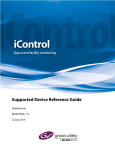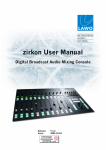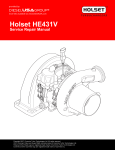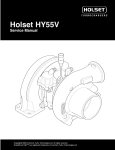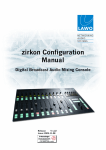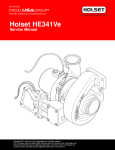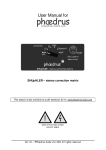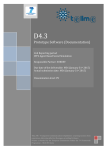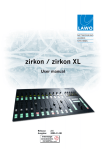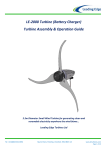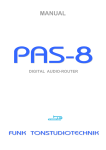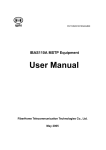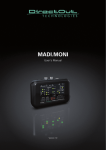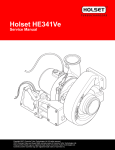Download Lawo HD Core manual - fra www.interstage.dk
Transcript
HD Core System Manual Release: Issue: V1.01 04-02-12 interstage Phistersvej 31, 2900 Hellerup, Danmark Telefon 3946 0000, fax 3946 0040 www.interstage.dk - pro audio with a smile Copyright All rights reserved. Permission to reprint or electronically reproduce any document or graphic in whole or in part for any reason is expressly prohibited, unless prior written consent is obtained from the Lawo AG. All trademarks and registered trademarks belong to their respective owners. It cannot be guaranteed that all product names, products, trademarks, requisitions, regulations, guidelines, specifications and norms are free from trade mark rights of third parties. All entries in this document have been thoroughly checked; however no guarantee for correctness can be given. Lawo AG cannot be held responsible for any misleading or incorrect information provided throughout this manual. Lawo AG reserves the right to change specifications at any time without notice. © Lawo AG, 2004 interstage Phistersvej 31, 2900 Hellerup, Danmark Telefon 3946 0000, fax 3946 0040 www.interstage.dk - pro audio with a smile Contents Contents PREFACE About this manual Manual Structure Typographical Markers Conventions of the Notes WARNING NOTES INTRODUCTION HD CORE Front Rear System Block Diagram (Matrix) System Block Diagram (Mixing Console) INSTALLATION Warning Notes Fitting the Frame Ambient Conditions Air-conditioning Requirements Replacing of Fans Power Supply and Grounding Grounding the System Installing Power Supply Units Assembly of the HD Core Warning notices for assembly Connector Panels Mounting of Connector Panels Slots at the Front Plug-in Cards Equipping with Plug-in Cards Procedure of Equipping Synchronisation Ports for Synchronisation Selecting the Clock Source Alarm/ Contacts TECHNICAL DETAILS 980/01 Frame 980/22 PSU 980/14 Connector Panel D-Sub 980/15 Connector Panel BNC 980/31 Module ROUTER 981/32 Module ROUTER HD Core V1.01 5 5 5 5 6 7 9 9 9 10 10 11 11 11 11 12 12 13 13 14 15 15 16 17 18 19 20 21 23 23 25 26 29 30 31 32 33 34 36 3 Contents 981/02 981/31 981/32 981/56 983/02 GLOSSARY INDEX 4 Module AES3 Module MADI Modul MADI Module ATM Module DSP 38 39 40 41 42 43 45 V1.01 HD Core Preface Preface About this manual The HD Core is the central component of the products Nova73 HD (application matrix) and mc² series HD (application mixing console). This manual gives instructions for preparing and installing the system core. It serves as a reference book for the system administrator and the service staff. Manual Structure The following paragraphs explain briefly the contents of the chapters. This gives you a detailled overview over the manual structure. Chapter 1 Warning Notices Includes general warnings about the handling of low voltage devices and first aid in case of electric shock. Chapter 2 Introduction about HD Core Offers a brief overview over the system components as well as a block diagram that illustrates a possible system structure. Chapter 3 Commissioning Describes the installation of the plug-in cards, the power supply units and the fans. Please note the safety instructions. Chapter 4 Technical Details In this chapter you find a detailled description of the individual components. Typographical Markers For easy handling and orientation with this manual at hand you will find here some explanations about the most important typographical markers. Chapter The headlines are marked by bold and large font. The headlines structure the topics to guarantee fast orientation. 1. Instruction HD Core V1.01 5 Preface The instructions are listed with numbers. These numbers serve for showing you the reasonable sequence of actions. This way you have always an overview over the complete instruction sequence. Result The results are written in italic letters. They inform about intermediate as well as final results to give you the chance to identify errors at an early stage. Marginal Note Marginal Note The marginal note serves as eye-catcher. Next to the marginal note you will find useful tips, notes or warnings. About warnings you will learn more in the paragraph conventions. Conventions of the Notes Tip Note This symbol is followed by useful tips! This symbol signifies that something is pointed out to you. Notes include useful suggestions or cross-references to records not included in this document. This symbol appears when something must be observed strongly. Not observing the warnings can cause heavy damages of the device and perilous bodily injuries. Please absolutely observe notes with this symbol. 6 V1.01 HD Core Warning Notes Warning Notes Attention: Read all notes with this “attention” symbol before installing the device. Observe all these notes during installation. Please observe also all other operation and application notes. Attention: Check the device and the accessories with regard to transport damages. A device damaged mechanically or by the intrusion of liquids must not be connected to the mains supply or must be disconnected from it immediately by pulling the power plug. Attention: If the device is not operated with a mains power supply unit please use only such line cords with three-leads as provided with the delivered product. Attention: By removing parts of the casing, shields, etc., live parts are laid open. Therefore you must strictly observe the following safety instructions: • Manipulations inside the device must be carried out by qualified service personnel and only under observance of the applicable regulations. • Inside the device are no user-serviceable parts. Attention: Before removing parts of the casing of individual components the device must be switched off and disconnected from the mains supply in any case. • Before opening the device the power supply capacitor must be discharged with a suitable resistor. • Components that carry heavy electrical loads like power transistors and resistors should not be touched until cooled off to avoid burns. HD Core V1.01 7 Warning Notes Attention: Servicing unprotected and operating devices can be carried out only by instructed qualified personnel at their own risk. The following instructions must be observed: • Never touch bare wires or circuitry • Use insulated tools only • Do not touch metal semi-conductor casings as they can bear high voltages. Attention: First Aid (in case of electric shock): • Separate the person as quickly as possible from the electric power source: ο Switch off the equipment ο Unplug or disconnect the mains cable ο Push the person away from the power source by using dry insulating material ( such as wood or plastic) If the person is unconscious: • Check the pulse If respiration is poor: • Reanimate the person • Lay the body down and turn it to one side (recovery position) • Call for a doctor immediately Attention: Do not touch the person or his/her clothing before power is turned off, otherwise you stand the risk of sustaining an electric shock as well! 8 V1.01 HD Core Introduction HD Core Introduction HD Core For giving you an overview over the individual components we describe here the most important elements and their function in the system. Front This graphic shows an assembled HD Core in the front view. The front of the frame offers: • 2 slots for central cards, control interfaces (depending on equipment): ο ATM ο Ethernet TCP/IP ο RS422 • 16 slots for I/O cards and DSP cards, audio interfaces (depending on equipment): ο AES/EBU (AES3) ο MADI (AES10) ο ATM ο Further formats as well as decentralised structures can be realised with I/O satellites (particularly with the I/O system DALLIS) • 2 slots for power supply units Rear This graphic shows the HD Core in the rear view. The rear of the frame offers: • Inputs and outputs for synchronisation, accepted formats: ο AES/EBU (AES3) ο Video (PAL und NTSC) ο Word clock • Alarm and control contacts • The possibility to mount up to 8 connector panels for frontal AES3 plug-in cards • 5 fans, hot-pluggable and accessible from outside HD Core V1.01 9 Introduction HD Core System Block Diagram (Matrix) The following block diagram illustrates a possible system structure for the application matrix. Ethernet-Switch Dial-up Router (remote maintenance) 3rd-Party Control MADI/ATM HD Core DALLIS I/O System Block Diagram (Mixing Console) The following block diagram shows the system structure with a HD Core used as system core of a mc² HD mixing console. Ethernet-Switch mc² HD Console Dial-up Router (remote maintenance) 3rd-Party Control MADI/ATM ATM Realtime Control System 10 HD Core V1.01 DALLIS I/O HD Core Installation Installation This chapter gives you an overview over the installation of the mounting frame and its individual components. These particulars are relevant also for commissioning and initial operation as well as servicing purposes. Warning Notes Attention! The electrical interfaces must be supplied only with voltages and signals that are mentioned in these instructions and specified in the respective standards (e.g. recommendations of the Audio Engineering Society). Attention! Do not use the HD Core at extreme temperatures. • Proper operation can be only guaranteed for the use at temperatures between 10°C and 35°C and a maximum relative humidity of 85% (not condensing)! Fitting the Frame The HD Core is designed for being fitted fix into 19’’ mounting racks. Ambient Conditions Proper operation can be only guaranteed at an ambient temperature between 10° C and 35° C, and a relative humidity between 15% and 85% (not condensing) during operation of HD Core. The proper storing conditions for the HD Core when out of action are a temperature between 0° C and 40° C and a relative humidity range of 10% and 85% (not condensing). HD Core V1.01 11 Installation Fitting the Frame Air-conditioning Requirements The HD Core is cooled actively by built-in fans. The air stream is guided from bottom front to top rear through the frame. The air-flow rate depends on the mounted components. The maximal air-flow rate will be about. 200 m³/h. The life cycle of a fan is typically 70.000 operating hours (at a maximum ambient temperature of 40° C). Replacing of Fans Each of the 5 fans can be replaced individually. This is also possible during operation. Screw Screw Screw Screw Connector 1. Loosen the screws of the fan! 2. Take the fan out of the frame! 3. Unplug the 4-pin connector from the frame! The fan is removed Fitting a new fan: 4. Plug the 4-pin connector into the coupler of the frame! 5. Insert the fan into the frame! 6. Fasten the screws of the fan! The fan is installed and secured. 12 V1.01 HD Core Installation Power Supply and Grounding Power Supply and Grounding The system core must be grounded before operation. For satisfactory safety the HD Core is connected with the ground wire of the power supply system via the device plug. Attention! For safety reasons an additional grounding connection must be installed and attached directly to the frame. Grounding the System 1. Use the M4 screw thread at the rear of the housing! For Ground Terminal Lock Washer Ring Terminal Screw M4 Ground Wire 2. Attach an additional grounding connection to the M4 screw thread! 3. Attach the grounding connection to the ground wire! HD Core V1.01 13 Installation Power Supply and Grounding Installing Power Supply Units For information about the technical data of the power supply units (PSU) please consult the respective paragraph in this document. Note The frame offers two slots for the installation of power supply units. For the power supply of the complete frame one PSU is sufficient, a second one can be installed as redundant component. With delivery, usually both PSU slots of the HD Core are occupied. If not please proceed as follows: PSU 1 PSU 2 1. See that the PSU is switched off! 2. Insert the PSU into slot 1 until it locks in place with the wrap connection! Screw Power Switch Screw 3. Secure the PSU by using the respective screws! The PSUs are set back from the frame front panel by about 6 cm. 4. Plug the power plug into the PSU! Screw Mains Socket (IEC) Screw 5. Connect the power plug with the mains socket! The PSU 1 is installed. For a redundant PSU please execute the steps 1-5 again. Attention For air conditioning reasons, a HD Core in operation requires that both PSU slots are occupied. If you do not wish to have a redundant PSU please insert in any case a dummy housing (Type 980/22) in the PSU slot 2! 6. Switch both PSUs on! 14 V1.01 HD Core Installation Assembly of the HD Core Assembly of the HD Core Only after equipped with plug-in cards the HD Core becomes an operative unit. When installing the components please mind the safety instructions mentioned below. Follow the order described below and mind the requirements and restrictions with regard to positioning. Warning notices for assembly The assembly of the frame and the module handling must be carried out with the utmost carefulness. Equipping must be performed by authorised personnel only as the plug-in cards carry highly sensitive electronic components. Attention! In principle always observe the following rules: • Discharge yourself before touching a plug-in card. • Wear conductive safety shoes and grounding wristbands. This reduces the risk of electrostatic charging. • Avoid bending the cards at any rate. • Mind that the plug-in cards glide smoothly in the top and bottom guide-rails. Only then can the cards lock in place correctly at the contact inside. • The card front panels serve as protection against contact with live parts and thus must be fastened. HD Core V1.01 15 Installation Assembly of the HD Core Connector Panels Beside the plug connectors on their front plates, certain plug-in cards require additional connectors. For this, connector panels are installed at the rear of the frame. Whether a plug-in card requires a connector panel is included in the technical description of the respective module type. Attention! In principle always observe the following rules: • Where no connector panels are required please cover the rear of the frame with dummy plates of the type 980/13. Connector panels are available in different types and can be used also in a mix: • Type 980/14 D-Sub, 8HP for connection AES3, balanced 110 Ω • Type 980/15 BNC, 16HP for connection AES3-id, unbalanced 75 Ω Depending on their width it is possible to insert 4 to 8 connector panels with the respective plug-in cards. Note 16 For the technical details as well as for information about the connection assignments please consult the respective paragraph in this document. V1.01 HD Core Installation Assembly of the HD Core Mounting of Connector Panels The connector panels are screwed to the rear of the frame. Possibly present dummy plates need to be removed. Attention The connector panel must be mounted before inserting the respective plug-in card! Mount the required connector panels progressing from right to left filling up the slots (seen from the rear): 1. Establish the first free slot (seen from the right) at the rear of the frame. 2. Remove potentially mounted dummy plates. Dummy plates are 8HP wide. If you want to mount a connector panel with a width of 16HP you have to remove two dummy plates. Note 3. Position the connector panel in a way that the inscription is readable the right way. 4. Fasten the connector panel with its 4 screws. Repeat this procedure for every further connector panel. The next is placed always left from that one just mounted. Later the respective active modules (plug-in cards) must be inserted left-aligned (seen from the front right-aligned) with the connector panels! HD Core V1.01 Note 17 Installation Assembly of the HD Core Slots at the Front In all there are 18 slots available. The two central slots (A and B) serve for insertion of central cards, the slots 1...16 are reserved for I/O- and DSP cards. HD Core / Slot No. 1 3 2 5 4 7 6 A 8 9 B 11 10 13 12 15 14 16 For the operation of the system at least the slot A must be equipped with a Central Module of the types 980/31 or 980/32. Attention! Not every module can be used in every slot. Please note in any case the respective restrictions and requirements (see below). Only then the proper functioning of the system can be guaranteed. 18 V1.01 HD Core Installation Assembly of the HD Core Plug-in Cards The following modules are designed for use in the HD Core. Please note the restrictions with regard to the possible slots! Central modules 980/31 Routing Matrix 3k² ROUTER Slots A, B 980/32 Routing Matrix 8k² ROUTER Slots A, B The slots A and B must be supplied always with modules of the same type! I/O modules 981/02 AES3 32 in- and outputs AES/EBU (via a rear connector panel); 1 Port MADI (optical) Slots 2,4,6,8,10,12,14,16 (depending on width of connector panel) 981/31 MADI 2 ports MADI (optical) All slots beside A, B 981/32 MADI 2 double ports MADI (optical, connection of redundant fibre) All slots beside A, B 981/53 ATM 3 ports ATM (optical) With ROUTER 980/31: slots 1,3,5,7,9,11,13,15 With ROUTER 980/32: all slots beside A, B 981/56 ATM 6 double ports MADI (optical, connection of redundant fibre) With ROUTER 980/31: slots 1,3,5,7,9,11,13,15 With ROUTER 980/32: all slots beside A, B DSP modules DSP 24 mc² 24 channels for mixing consoles mc² series Slots 1,3,5,7,9,11,13,15 For a detailled description please consult „Technical Details“. HD Core V1.01 19 Installation Assembly of the HD Core Equipping with Plug-in Cards 1. Release the handles of the card by pressing on the light grey area (included in the handle) 2. Lift up / pull down the handles of the board! 3. Set the card in the guide rails! 4. Insert the card completely into the frame! The card locks into place and the handles lock the card as soon as it reaches the contact in the frame. 5. Fasten the screws at the handles for additional securing of the card! 6. Equip the slots according to the requirements. Attention! Not every plug-in card can be used in every slot. Please note in any case the respective restrictions and requirements (see below). Only then the proper functioning of the system can be guaranteed. 20 V1.01 HD Core Installation Assembly of the HD Core Procedure of Equipping “Technical Details” mentions the permitted slots for each plug-in card. Please proceed as follows to avoid mistakes and to guarantee proper operation. 1. Insert a plug-in card of the types 980/31 or 980/32 into slot A. If a redundant module is required please insert this into slot B. Attention! The slots A and B must be always equipped with modules of the same type! 2. Mount the plug-in cards of the type 981/02 AES3 progressing from left to right filling up the slots predetermined by the connector panels. Attention! The connector panel must be mounted before inserting the plug-in card (procedure see above)! If a module of the type 981/02 has no connection to a rear connector panel its LED under „AES3 LOCK” labelled with „1“ is blinking red. In this case you might have selected the wrong slot. 3. Insert the plug-in cards of the type 983/02 DSP progressing from right to left filling up the slots 15, 13, 11, 9, 7, 5, 3, 1. The logical numbering of the DSP cards follows the mounting order of the equipment from right to left (DSP card 1 in slot 15, DSP card 2 in slot 13, etc., see below). HD Core V1.01 Note 21 Installation Assembly of the HD Core Logical Numbering of DSP Boards 8 7 6 5 4 3 2 1 4. Insert the plug-in cards of the type 981/31 MADI progressing from left to right filling up the slots 2, 4, 6, 8, 10, 12, 14, 16 (if not yet occupied). Use then the slots 1, 3, 5, 7, 9, 11, 13, 15 (progressing from left to right filling up the slots if not yet occupied). 5. Repeat the procedure described under point 4 for modules of the type 981/32 MADI 6. When using a central card 980/31: insert the modules of the type 981/56 ATM progressing from left to right filling up the slots 1, 3, 5, 7, 9, 11, 13, 15 (if not yet occupied) 7. When using the central card 980/31: repeat the procedure described under point 6 for modules of the type 981/53 ATM 8. When using the central card 980/32: insert the modules of the type 981/56 ATM progressing from left to right filling up the slots 2, 4, 6, 8, 10, 12, 14, 16 (if not yet occupied). Use then the slots 1, 3, 5, 7, 9, 11, 13, 15 (progressing from left to right filling up the slots if not yet occupied) 9. When using the central card 980/32: repeat the procedure described under point 8 for modules of the type 981/53 ATM After completing the procedure all plug-in cards should be installed in the frame. If this is not so then this is a case of an inoperative excess equipment! 22 V1.01 HD Core Installation Synchronisation Synchronisation The HD Core is a digital system and thus must be synchronised. This is achieved by the internal clock generator or external clock sources. For synchronisation there are inputs and outputs at the rear of the frame. The active synchronisation units are realised on the central modules and, together with these, can be supplied redundantly. Ports for Synchronisation On the central console of the frame’s rear you find the ports for synchronisation. Sync inputs (Input 1/2) accept WORDCLOCK, VIDEO or AES/EBU (AES3). Ensure the proper termination of the inputs with 75 Ohm on the looped-through outputs (Thru 1/2). INPUT 1 INPUT 2 SYNCHRONISATION THRU 1 WCLK OUT THRU 2 • INPUT 1 and 2 serve for the synchronisation of the system core to external clock sources. The inputs accept word clock, AES3-id and video (PAL 625 lines/50 Hz and NTSC 525 lines/59.94 Hz). The format is identified automatically. Attention! The HD Core supports only one video format at a time. Thus, if both inputs are supplied with video signals only signals of the same type are to be used (either PAL or NTSC). HD Core V1.01 23 Installation Synchronisation • At the outputs THRU 1 and 2 it is possible to pick up the signals supplied at Input 1 and 2. This can be used for the chaining of several participants. Attention! At THRU 1/2 you cannot pick up the real system clock but only the looped-through input signal of INPUT 1/2. Attention! When no further participant is connected to THRU 1/2 it is absolutely necessary to plug on a terminating resistor of 75 Ω. Terminating resistors designed as BNC connectors are included in delivery. Tip A star-like clock distribution via distribution amplifier offers better signal quality and should be preferred to that of a passive chaining. • The real system clock can be picked up at the output WCLK OUT (word clock). This adapts to the selected external clock source or the internal generator. • By way of configuration it is possible to define a multichannel signal (MADI or ATM) as external clock source. 24 V1.01 HD Core Installation Synchronisation Selecting the Clock Source The HD Core can be synchronised via 4 clock sources (multi-channel port, Input 1, Input 2 and internal generator). Which of the clock sources serves as reference and which is used as redundant one in case of error is defined by an internal hierarchy. This hierarchy applies as long as nothing else is predetermined by external control. Hierarchy level Sync source Utilisable signal type Comment (1) Multi-channel • ATM port • MADI (if configured) Auto-detect of signal type (2) Redundant • ATM port of 1 • MADI (if configured) Signal depends on 1 3 Sync input 1 • Word clock Auto-detect of signal type • Video: PAL, NTSC • AES 3 4 Sync input 2 • Word clock Auto-detect of signal type • Video: PAL, NTSC • AES 3 5 Internal • Generator Can be deemed as fault (depending on configuration) An automated switching is triggered exclusively with the failure of the current clock source. In this case it will be switched to that one available which is highest in the hierarchy. Is the failed clock source available again there is no automated switching back (except synchronisation to internal generator is deemed as fault: in this case every valid external signal is prior to the internal generator at any time). HD Core V1.01 25 Installation Alarm/ Contacts Alarm/ Contacts On the central console of the frame’s rear you find the connectors for alarm contacts and control inputs. GLOBAL ALARM GPI 1 GPI 2 25 Note that their function depends partly on the equipment of the frame with central cards. However, this does not apply for the outputs GLOBAL ALARM and PSU ALARM. Inputs: (opto-coupler, 5 V…24 V, galvanically isolated) typ. 3 mA, floating and • ROUTER TAKEOVER Using this input it is possible to force the takeover by the redundant central module. This process is triggered by a positive edge at the input. • PREPARE COLDSTART Using this input it is possible to carry out a coldstart (only in connection with restart/reset). This requires a voltage being supplied at this input during the restart. 1 25 Outputs: relays max. 30V/ 500mA Inputs: optocouplers 3...30V/ typ. 8mA 1 • ALARM IN 1-4 These inputs serve for the surveillance of peripherals (e. g. devices of other manufacturers). Making use of the configuration, you can define freely an error message (text) for each input and define the activation of the collective alarm. Predefined standards are: ο ALARM 1 IN: failure of the external clock supply (activating of the collective alarm) ο ALARM 2 IN: failure of the external power supply (activating of the collective alarm) ο ALARM 3 IN: failure of the external I/O system (activating of the collective alarm) ο ALARM 4 IN: externally measured temperature exceedance (activating of the collective alarm) The alarm is triggered by applied voltage. When the input is open or grounded the alarm is cancelled. • GENERAL PURPOSE IN 1-2 Inputs for the project-specific adaptation 26 V1.01 HD Core Installation Alarm/ Contacts Outputs: (Relay, max. 30V/500mA, floating and galvanically isolated) • CTRL LIFE WATCH Alarm contact, that reports the loss of a connection to a superordinated control system (requires project-specific adaptation) • 2nd ROUTER ACTIVE Alarm contact that reports dedicatedly the activation of the redundant central module (closed status) • PSU ALARM Alarm contact that reports dedicatedly a failure of the PSUs (closed status). • GLOBAL ALARM Collective alarm contact which signals the occurrence of any failure (closed status). This can be picked up parallel via BNC and D-Sub • GENERAL PURPOSE OUT 1-2 Outputs for project-specific adaptation Voltage feed: (short-circuit proof) • At the D-Sub connectors GPI 1 and GPI 2 it is possible to pick up +5V each and with a maximum current of 150mA each. HD Core V1.01 27 Technical Details Technical Details HD Core V1.01 29 Technical Details 980/01 Frame • 19“ frame with one component level, height 10 RU • 2 slots for central cards (width 10 HP) • 16 slots for I/O cards and DSP cards (width 4 HP) • Double-star architecture of the backplane • Active ventilation (bottom front to top rear) • Temperature- and voltage surveillance • Connectors for synchronisation and alarm Power supply • 2 slots for power supply units (PSU) • One PSU required, second as redundant component • PSU replaceable during operation (hot-pluggable) Dimensions/Weight • Width 19“ respective 483mm (front panel)/440mm (housing) • Height 10 RU respective 445mm • Depth 510 mm • Weight 11.5 kg Zubehör • 980/11 dummy plate front 4 TE (weight 450 g) • 980/12 dummy plate front 10 TE (weight 600 g) • 980/13 dummy plate rear 8 TE (weight 140 g) • 980/21 dummy housing for PSU slot (weight 1.3 kg) • 940/21 cable duct 19” / 1 RU 30 V1.01 HD Core Technical Details 980/22 PSU • Power supply unit for the power supply of the frame type 980/01 • Also adaptable as redundant PSU Characteristics: • Input voltage (primary side): 85-265 VAC / 47–63 Hz • Power consumption: 8,2 A at 100 VAC resp. 4,1 A at 200 VAC • Output voltage (secondary side): 48VDC • Current flow/power drain: 13A max. 624 W Dimensions/weight: • Width 213 mm • Height 128 mm • Depth 317 mm • Weight 4.25 kg HD Core V1.01 31 Technical Details 980/14 Connector Panel D-Sub • Connector panel to be mounted at the rear of the frame type 980/01 • Signal supply by plug-in card at the front (seen from the front: on the slot left-aligned to the connector panel) • Supported by ο Plug-in card 981/02 for realising the AES3 interfaces (transformer coupled) • Outputs: 4 plugs D-Sub 25-pin, each with 8 balanced contacts 110 Ω • Inputs: 4 plug sockets D-Sub 25-pin, each with 8 balanced contacts 110 Ω Dimensions/Weight • Width 8HP • Height 342,8 mm • Weight 500 g Pin assignment Outputs 1…8 Outputs 9…16 Inputs 1…8 Inputs 9…16 Outputs 17…24 Inputs 17…24 Outputs 25…32 Inputs 25…32 32 V1.01 HD Core Technical Details 980/15 Connector Panel BNC • Connector panel to be mounted at the rear of the frame type 980/01 • Signal supply by plug-in card at the front (seen from the front: on the slot left-aligned to the connector panel) • Supported by ο Plug-in card 981/02 for realising the AES3 interfaces (transformer coupled) • Outputs: 32 BNC connector, un-balanced contacts 75Ω • Inputs: 32 BNC connector, un-balanced contacts 75Ω Dimensions/Weight • Width 16HP • Height 342,8 mm • Weight 900 g HD Core V1.01 33 Technical Details 980/31 Module ROUTER • Central module for HD Core, supplies ο Routing matrix ο Synchronisation unit ο System management Routing matrix • 3072 crosspoints • Slots 1, 3, 5, 7, 9, 11, 13, 15 each with 256 time slots • Slots 2, 4, 6, 8, 10, 12, 14, 16 each with 128 time slots Control and service interfaces • • Ethernet TCP/IP 10/100 Mbit/s ο Interface for matrix control via Lawo “MNOPL Remote” protocol ο Control interface for mc² mixing console application ο Service interface for maintenance and configuration ο IP address: 192.168.102.1, mask 255.255.255.0; Preset, can be changed (project specific definition) ATM 155MBit ο • Control interface for mc² mixing console application RS422 ο Interface for matrix control ο Service interface Push-buttons • PREPARE COLD START (moment key) For executing a coldstart (only in connection with restart/reset). For this purpose, the push-button must be held pushed during the restart. • LAMP TEST (latched key) Serves for testing the LEDs. Activates the LEDs of all components of the frame. • MODULE TAKEOVER (installed recessed, moment key) When frame is equipped with redundant central card: forces the switching over to the inactive module. • RESET (installed recessed, moment key) Triggers a restart of the module Indicators 34 • ACTIVE (green, blinking) Indicates that the currently active module is ready to operate. In case of error this LED goes out or pauses. • STANDBY (yellow, blinking) Indicates that the redundant / inactive module is ready to operate. In case of error this LED goes out or pauses. • GLOBAL ALARM (red, static) Indicates an activated collective alarm. V1.01 HD Core Technical Details • COLD START (red) Indicates the preparation for the coldstart. It is activated by the respective button of the central module or the contact on the frame’s rear. • Synchronisation Available clock sources (e. g. supply of a proper signal) are indicated by the blinking of the respective LED. The current reference clock source shows permanently. The following clock sources / indications are possible: ο MULTI-CHANNEL (green) ο INPUT 1 (green) ο INPUT 2 (green) ο INTERNAL (configurable: green - operation on internal generator is permitted red - operation on internal generator is defined as error) Power consumption • Power consumption 20 W Dimensions/Weight • Width 10 HP • Length 490 mm • Height 265 mm • Weight 1200 g HD Core V1.01 35 Technical Details 981/32 Module ROUTER • Central module for HD Core, supplies ο Routing matrix ο Synchronisation unit ο System management Routing matrix • 8192 crosspoints • All slots support 512 time slots each Control and service interfaces • • Ethernet TCP/IP 10/100 Mbit/s ο Interface for matrix control via “Lawo MNOPL Remote” protocol ο Control interface for mc² mixing console application ο Service interface for maintenance and configuration ο IP address: 192.168.102.1, mask 255.255.255.0; Preset, can be changed (project specific definition) ATM 155MBit (Duplex SC, MMF 62,5/125 at 1300nm) ο • Control interface for mc² mixing console application RS422 (connector row D-Sub 9-pin) ο Interface for matrix control ο Service interface Push-buttons • PREPARE COLD START (moment key) For executing a coldstart (only in connection with restart/reset). For this purpose, the push-button must be held pushed during the restart. • LAMP TEST (latched key) Serves for testing the LEDs. Activates the LEDs of all components of the frame. • MODULE TAKEOVER (installed recessed, moment key) When frame is equipped with redundant central card: forces the switching over to the inactive module. • RESET (installed recessed, moment key) Triggers a restart of the module Indicators 36 • ACTIVE (green, blinking) Indicates that the currently active module is ready to operate. In case of error this LED goes out or pauses. • STANDBY (yellow, blinking) Indicates that the redundant / inactive module is ready to operate. In case of error this LED goes out or pauses. • GLOBAL ALARM (red, static) Indicates an activated collective alarm. V1.01 HD Core Technical Details • COLD START (red) Indicates the preparation for the coldstart. It is activated by the respective button of the central module or the contact on the frame’s rear. • Synchronisation Available clock sources (e. g. supply of a proper signal) are indicated by the blinking of the respective LED. The current reference clock source shows permanently. The following clock sources / indications are possible: ο MULTI-CHANNEL (green) ο INPUT 1 (green) ο INPUT 2 (green) ο INTERNAL (configurable: green - operation on internal generator is permitted red - operation on internal generator is defined as error) Power consumption • Power consumption 20 W Dimensions/Weight • Width 10 HP • Length 490 mm • Height 265 mm • Weight 1200 g HD Core V1.01 37 Technical Details 981/02 Module AES3 • I/O card for HD Core, supplies ο Audio interfaces AES3 and MADI (AES10) ο Signal processing Audio interfaces • • 32 inputs AES3 (stereo) ο individually switchable sampling rate converters (SRC) (autorange 28…100kHz) ο can be picked up via connector panels type 980/14 or 980/15 32 outputs AES3 (stereo) ο • can be picked up via connector panels type 980/14 or 980/15 1 port MADI ο 56 or 64 channels bi-directional (configurable) ο LWL/Duplex SC, MMF 62,5/125 at 1300nm Signal processing • Input-sided silence detect, phase reverse, gain, balance • Output-sided phase reverse, gain, balance, mono matrix, silence detect Requirements • The card can be plugged into all slots with at least 128 time-slots Indicators • ACTIVE (green, blinking) Indicates that the module is ready to operate. In case of error this LED goes out or pauses. • AES3-Ports ο • LOCK (1…32, green, static), indicates that a valid signal is supplied at the respective input The LED for the first input is two-coloured and indicates by blinking red if the respective connector panel is missing. MADI port: ο LOCK/ERROR, indicates a supplied MADI signal (green, constant light), light at the optical input (green, blinking) or a transfer error (red, static) ο STANDBY (yellow, blinking ) Indicates that the port is in inactive status (redundant) Power consumption • Power consumption 30 W Dimensions/Weight 38 • Width 4 HP • Length 490 mm • Height 265 mm • Weight 900 g V1.01 HD Core Technical Details 981/31 Module MADI • I/O card for HD Core, supplies ο Audio interfaces MADI (AES10) ο Signal processing Audio interfaces • 2 ports MADI ο 56 or 64 channels bi-directional (configurable) ο LWL/Duplex SC, MMF 62,5/125 at 1300nm Signal processing • Input-sided silence detect, phase reverse, gain, balance • Output-sided phase reverse, gain, balance, mono matrix, silence detect Requirements • The card can be plugged into all slots with at least 128 time-slots Indicators • ACTIVE (green, blinking) Indicates that the module is ready to operate. In case of error this LED goes out or pauses. • MADI ports: ο LOCK/ERROR, indicates a supplied MADI signal (green, constant light), light at the optical input (green, blinking) or a transfer error (red, static) ο STANDBY (yellow, blinking ) Indicates that the port is in inactive status (redundant) Power consumption • Power consumption 10 W Dimensions/Weight HD Core • Width 4 HP • Length 490 mm • Height 265 mm • Weight 750 g V1.01 39 Technical Details 981/32 Modul MADI • I/O card for HD Core, supplies ο Audio interfaces MADI (AES10) ο Signal processing Audio interfaces • 2 ports MADI, each with 2 connections (for redundant fibre) ο 56 or 64 channels bi-directional (configurable) ο LWL/Duplex SC, MMF 62,5/125 ati 1300nm Signal processing • Input-sided silence detect, phase reverse, gain, balance • Output-sided phase reverse, gain, balance, mono matrix, silence detect Requirements • The card can be plugged into all slots with at least 128 time-slots Indicators • ACTIVE (green, blinking) Indicates that the module is ready to operate. In case of error this LED goes out or pauses. • MADI ports: • LOCK/ERROR, indicates a supplied MADI signal (green, constant light, only active port), light at the optical input (green, blinking) or a transfer error (red, static) • STANDBY (yellow, blinking ) Indicates that the port is in inactive status (redundant) Power consumption • Power consumption 15 W Dimensions/Weight 40 • Width 4 HP • Length 490 mm • Height 265 mm • Weight 750 g V1.01 HD Core Technical Details 981/56 Module ATM • I/O card for HD Core, supplies ο Audio interfaces MADI (AES10) ο Signal processing Audio interfaces • 6 ports ATM, each with 2 connections (for redundant fibre) ο 80 channels bi-directional (configurable) ο LWL/MT-RJ, MMF 62,5/125 at 1300nm ο Special bridging mode for the looping-through of the signal without routing matrix Signal processing • Input-sided silence detect, phase reverse, gain, balance • Output-sided phase reverse, gain, balance, mono matrix, silence detect Requirements • The card can be plugged into all slots with at least 512 time-slots • In the downwards compatible mode, the upper 3 ports of the card can be used with 256 time slots. Indicators • ACTIVE (green, blinking) Indicates that the module is ready to operate. In case of error this LED goes out or pauses. • ATM ports: ο LOCK/ERROR, indicates a supplied ATM signal (green, constant light, only active port), light at the optical input (green, blinking) or a transfer error (red, static) ο BRIDGE (yellow, blinking ) Indicates that the port is in the bridge status Power consumption • Power consumption 35 W Dimensions/Weight HD Core • Width 4 HP • Length 490 mm • Height 265 mm • Weight 750 g V1.01 41 Technical Details 983/02 Module DSP • DSP card for HD Core, supplies ο Signal processing for mixing console applications (mc² series) Signal processing • 24 channels with 48 signal paths • 12 sums Requirements • The card can be plugged into the slots 1, 3, 5, 7, 9, 11, 13, 15 Indicators • ACTIVE (green, blinking) Indicates that the active module is ready to operate. In case of error this LED goes out or pauses. • STANDBY (yellow, blinking) Indicates that the redundant / inactive module is ready to operate. In case of error this LED goes out or pauses. • ERROR (red) Visualises an error in the signal processing (e. g. CRC). The LED serves not for indicating a general module error. Power consumption • Power consumption 50 W Dimensions/Weight • Width 4 HP • Length 490 mm • Height 265 mm • Weight 750 g • 42 V1.01 HD Core Glossary Glossary ATM Asynchronous Transfer Mode (Packing of signals in small portions; commonly used and highly standardised network protocol) Balance Ratio of the level between left and right channel of a stereo signal. Weighting the signal to the left means the diminishing of the level on the right. Core Core of the system (Lawo core includes routing system and DSP) dB decibel dB describes ratios, like percentage does. As long as dB is not completed by a reference , e. g. dB(A) it works as a factor, i. e. a number multiplied with another. dBr Relative voltage level according to the following equation: dBr=20lg U2/U1 dBu Measure of the absolute voltage level based on 0,775 Volts. 0 dBu equals 0,775 V (RMS). The radio house norm level of +6 dBu is 1,55 V The studio level of +4 dBu is 1,228 V Drop-out Interruption of the audio signal caused by an error in the signal transfer or recording. DSP Digital Signal Processor Central processing unit in a digital signal processor on a board. The DSP is used for processing of data in realtime, which means it can permanently receive, process and give out data without interruption. This allows also a permanent reverberation. Dynamic parameters Real audio parameters like e. g. fader or equalizer, the dynamics unit or the pan/bal module. Gain The gain control serves for the adjustment of the level to the requirements, i. e. an increase of the gain leads to amplification, whereas a reduction leads to an attenuation. GPI/O Actually GPI→General Purpose Interface Headroom Modulation reserve, usually at +9dB (Germany) MADI Multi-channel Audio Interface; digital interface for combining audio signals of 56 channels. This format serves for the transfer between digital mixing consoles and DASH recorders. Overload System is strained at the input with too large a level → nonlinear distortion Phantom power Power supply for condenser microphones. The mixing console supplies the microphone with the necessary power of 48V via the symmetrical audio cable. Reset = Warmstart Resets the system to the status after switching it on. HD Core V1.01 43 Glossary Routing Signal routing The routing of a way from input to output of the core. RU Rack Units Ј 44,45 mm resp. 1,75 inch Sampling rate Speed during collecting the measured values during the sampling SMPTE Abbreviation for Society of Motion Picture and Television Engineers Standardised protocol for the synchronisation of audio and video technology ЈTimecode SRC Sample Rate Converter Sources: Jürg Jecklin, „Musikaufnahmen”, 2 Auflage, Franzis Unterhaltungs-Elektronik Michael Dickreiter, „Handbuch der Tonstudiotechnik” Band 1/2” , 5 Auflage, K.G. Saur Jan Friedrich Conrad, „Taschenlexikon”, PPV Jan Friedrich Conrad, „Recording”, PPV Friedrich Guthmann, „Lexikon der Tontechnik” „KEYBOARDS”, Magazin für Musik und Computer, Ausgaben 12/00, 01/01, 02/01 User Manual mc² series (Version 1.7) 44 V1.01 HD Core Index Index HD Core V1.01 45 Lawo AG Rastatt/Germany Tel. +49 7222 1002-0 www.lawo.de














































